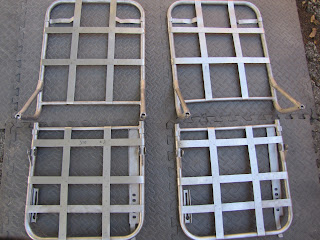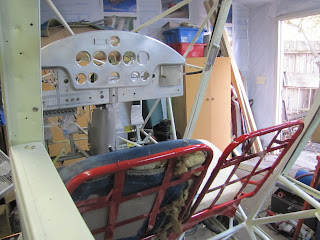Since I now had all my instruments I started putting the gauges in the instrument panel.
First I looked up the original panel location for each on the internet, then went over to see how they fit. I had to also fit the control wheels and shafts together--there's definitely a shaft that fits better on each one so I wonder if they're paired? Kevin had the control shafts re-chromed and the control wheels powder coated. This was the first time I put them back together. The shafts still need to have the receiving holes drilled on the universal joint to the control arm.
The black bezel on the oil press gauge (far left) needs to be re-painted.
I had to cut down the flange for the far right ammeter gauge with a hacksaw and cleaned it up (it was round and I made it a square so it fits side by side with the fuel gauge. It also needs to have the gauge loosened in it's bracket and straightened up (it's kinda crooked).
The Oil temp gauge is also kind of crooked and it needs to be loosened in it's holding bracket and straightened.
The fuel gauge has no bracket on it to hold it in place (pin it against the instrument panel to hold it in place) so I need to find it in the box of parts or fab one from aluminum and install.
Overall, they all now fit well on the panel. I need to scavenge some more instrument screws from the various extra instruments we have.
I also installed/fitted temporarily, the fuel selector valve (the other red-colored handle on the panel). I don't know if I have the valve in the right position, so I'll have to take off one of the fuel inlet tubes to visually check it's position before final installation. The fuel selector valve control rod needs to be primed too before installation.
We also got a digital timer for the center hole. It is new in the box, so I opened it and read the instructions. Inside the unit I found a 25 year old AAA battery that powered it. I need to get an industrial AAA battery before I install the timer/clock. I think the panel really looks great. It'll get painted someday when we get the aircraft paint.
I started using the just-completed paint booth. In order to attach more parts to the frame, I need to use these small "C" clips. Months ago I cleaned all these from all the rust and old paint in my blasting box. It took me 6 hours to clean, prep, and paint 79 C clips (found 2 more on the bench I didn't count before) and some assorted parts like the 2 door jamb strikers a support piece I'm not sure where it goes and the long piece on the left is the fuel selector extension from the switch on the panel to the fuel valve on the firewall.
I modified the paint booth with a larger 6" duct and took out my previous plenum that was causing turbulence. However, it still didn't draw correctly and the outflow felt kind of weak. I added 3 pieces of cardboard to the entrance to cut down the overspray coming out of the booth at me. However, I could still seem some overspray coming back at me and afterward found some overspray on my glasses.
I sprayed Polyfiber's epoxy primer which uses a catalyst and thinner to get the right viscosity for spraying. Using the $9 Harbor Freight HVLP sprayer was new and took some adjustments which I practiced on cardboard. Had to turn down the flow amount so it didn't run and then it seemed to work good. Mixed about the right amount of paint for the job as I only had about a 1/4" left in the mixing cup afterward. I also need to get more thinner from Polyfiber or some MEK as I'm running out.
Went back later that evening and checked it. The clips looked great and were white and smooth. Need to wait a week before I can use them on the plane, but very pleased with the results (which nobody will see but us and our inspector).
Here's the paint booth with lights on. I replaced that 3" exhaust duct with a 6" duct out the wall behind the booth.
All the "C" clips and the fuel selector shaft on the left.
Almost all painted in this photo. I put on another 2 coats. So many angles on these small parts!
Next I hope to work on the floorboards and some wood work and actually start using the "C" clips to install these wood parts on the airplane.





























































